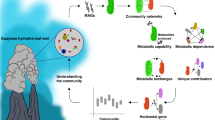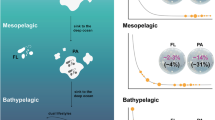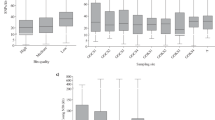Abstract
The extent of horizontal gene transfer (HGT) among marine pelagic prokaryotes and the role that HGT may have played in their adaptation to this particular environment remain open questions. This is partly due to the paucity of cultured species and genomic information for many widespread groups of marine bacteria and archaea. Molecular studies have revealed a large diversity and relative abundance of marine planktonic archaea, in particular of Thaumarchaeota (also known as group I Crenarchaeota) and Euryarchaeota of groups II and III, but only one species (the thaumarchaeote Candidatus Nitrosopumilus maritimus) has been isolated in pure culture so far. Therefore, metagenomics remains the most powerful approach to study these environmental groups. To investigate the impact of HGT in marine archaea, we carried out detailed phylogenetic analyses of all open reading frames of 21 archaeal 16S rRNA gene-containing fosmids and, to extend our analysis to other genomic regions, also of fosmid-end sequences of 12 774 fosmids from three different deep-sea locations (South Atlantic and Adriatic Sea at 1000 m depth, and Ionian Sea at 3000 m depth). We found high HGT rates in both marine planktonic Thaumarchaeota and Euryarchaeota, with remarkable converging values estimated from complete-fosmid and fosmid-end sequence analysis (25 and 21% of the genes, respectively). Most HGTs came from bacterial donors (mainly from Proteobacteria, Firmicutes and Chloroflexi) but also from other archaea and eukaryotes. Phylogenetic analyses showed that in most cases HGTs are shared by several representatives of the studied groups, implying that they are ancient and have been conserved over relatively long evolutionary periods. This, together with the functions carried out by these acquired genes (mostly related to energy metabolism and transport of metabolites across membranes), suggests that HGT has played an important role in the adaptation of these archaea to the cold and nutrient-depleted deep marine environment.
Similar content being viewed by others
Log in or create a free account to read this content
Gain free access to this article, as well as selected content from this journal and more on nature.com
or
References
Altschul SF, Madden TL, Schaffer AA, Zhang J, Zhang Z, Miller W et al. (1997). Gapped BLAST and PSI-BLAST: a new generation of protein database search programs. Nucleic Acids Res 25: 3389–3402.
Barns SM, Delwiche CF, Palmer JD, Pace NR . (1996). Perspectives on archaeal diversity, thermophily and monophyly from environmental rRNA sequences. Proc Natl Acad Sci USA 93: 9188–9193.
Béjá O, Aravind L, Koonin EV, Suzuki MT, Hadd A, Nguyen LP et al. (2000a). Bacterial rhodopsin: evidence for a new type of phototrophy in the sea. Science 289: 1902–1906.
Béjá O, Suzuki MT, Koonin EV, Aravind L, Hadd A, Nguyen LP et al. (2000b). Construction and analysis of bacterial artificial chromosome libraries from a marine microbial assemblage. Environ Microbiol 2: 516–529.
Brochier C, Bapteste E, Moreira D, Philippe H . (2002). Eubacterial phylogeny based on translational apparatus proteins. Trends Genet 18: 1–5.
Brochier-Armanet C, Boussau B, Gribaldo S, Forterre P . (2008). Mesophilic Crenarchaeota: proposal for a third archaeal phylum, the Thaumarchaeota. Nat Rev Microbiol 6: 245–252.
Brown JR, Zhang J, Hodgson JE . (1998). A bacterial antibiotic resistance gene with eukaryotic origins. Curr Biol 8: R365–R367.
DeLong EF . (1992). Archaea in coastal marine environments. Proc Natl Acad Sci USA 89: 5685–5689.
DeLong EF, Preston CM, Mincer T, Rich V, Hallam SJ, Frigaard NU et al. (2006). Community genomics among stratified microbial assemblages in the ocean's interior. Science 311: 496–503.
Edgar RC . (2004). MUSCLE: multiple sequence alignment with high accuracy and high throughput. Nucleic Acids Res 32: 1792–1797.
Frigaard NU, Martinez A, Mincer TJ, DeLong EF . (2006). Proteorhodopsin lateral gene transfer between marine planktonic Bacteria and Archaea. Nature 439: 847–850.
Fuchsman CA, Rocap G . (2006). Whole-genome reciprocal BLAST analysis reveals that planctomycetes do not share an unusually large number of genes with Eukarya and Archaea. Appl Environ Microbiol 72: 6841–6844.
Fuhrman JA, Davis AA . (1997). Widespread Archaea and novel Bacteria from the deep sea as shown by 16S rRNA gene sequences. Mar Ecol Prog Ser 150: 275–285.
Fuhrman JA, McCallum K, Davis AA . (1992). Novel major archaebacterial group from marine plankton. Nature 356: 148–149.
Ghai R, Martín-Cuadrado AB, Molto AG, Heredia IG, Cabrera R, Martín J et al. (2010). Metagenome of the Mediterranean deep chlorophyll maximum studied by direct and fosmid library 454 pyrosequencing. ISME J 4: 1154–1166.
Giovannoni SJ, Britschgi TB, Moyer CL, Field KG . (1990). Genetic diversity in Sargasso Sea bacterioplankton. Nature 345: 60–63.
Giovannoni SJ, Tripp HJ, Givan S, Podar M, Vergin KL, Baptista D et al. (2005). Genome streamlining in a cosmopolitan oceanic bacterium. Science 309: 1242–1245.
Gogarten JP, Doolittle WF, Lawrence JG . (2002). Prokaryotic evolution in light of gene transfer. Mol Biol Evol 19: 2226–2238.
Gogarten JP, Townsend JP . (2005). Horizontal gene transfer, genome innovation and evolution. Nat Rev Microbiol 3: 679–687.
Guindon S, Gascuel O . (2003). A simple, fast, and accurate algorithm to estimate large phylogenies by maximum likelihood. Syst Biol 52: 696–704.
Hacker J, Kaper JB . (2000). Pathogenicity islands and the evolution of microbes. Annu Rev Microbiol 54: 641–679.
Hallam SJ, Konstantinidis KT, Putnam N, Schleper C, Watanabe Y, Sugahara J et al. (2006). Genomic analysis of the uncultivated marine crenarchaeote Cenarchaeum symbiosum. Proc Natl Acad Sci USA 103: 18296–18301.
Hallam SJ, Putnam N, Preston CM, Detter JC, Rokhsar D, Richardson PM et al. (2004). Reverse methanogenesis: testing the hypothesis with environmental genomics. Science 305: 1457–1462.
Hastings PJ, Rosenberg SM, Slack A . (2004). Antibiotic-induced lateral transfer of antibiotic resistance. Trends Microbiol 12: 401–404.
Ivars-Martínez E, Martin-Cuadrado AB, D’Auria G, Mira A, Ferriera S, Johnson J et al. (2008). Comparative genomics of two ecotypes of the marine planktonic copiotroph Alteromonas macleodii suggests alternative lifestyles associated with different kinds of particulate organic matter. ISME J 2: 1194–1212.
Jain R, Rivera MC, Lake JA . (1999). Horizontal gene transfer among genomes: the complexity hypothesis. Proc Natl Acad Sci USA 96: 3801–3806.
Jobb G, von Haeseler A, Strimmer K . (2004). TREEFINDER: a powerful graphical analysis environment for molecular phylogenetics. BMC Evol Biol 4: 18.
Juhas M, van der Meer JR, Gaillard M, Harding RM, Hood DW, Crook DW . (2009). Genomic islands: tools of bacterial horizontal gene transfer and evolution. FEMS Microbiol Rev 33: 376–393.
Jurgens G, Lindstrom K, Saano A . (1997). Novel group within the kingdom Crenarchaeota from boreal forest soil. Appl Environ Microbiol 63: 803–805.
Karner MB, DeLong EF, Karl DM . (2001). Archaeal dominance in the mesopelagic zone of the Pacific Ocean. Nature 409: 507–510.
Könneke M, Bernhard AE, de la Torre JR, Walker CB, Waterbury JB, Stahl DA . (2005). Isolation of an autotrophic ammonia-oxidizing marine archaeon. Nature 437: 543–546.
Koski LB, Golding GB . (2001). The closest BLAST hit is often not the nearest neighbor. J Mol Evol 52: 540–542.
Krawiec S, Riley M . (1990). Organization of the bacterial chromosome. Microbiol Rev 54: 502–539.
Le SQ, Gascuel O . (2008). An improved general amino acid replacement matrix. Mol Biol Evol 25: 1307–1320.
López-García P, Brochier C, Moreira D, Rodríguez-Valera F . (2004). Comparative analysis of a genome fragment of an uncultivated mesopelagic crenarchaeote reveals multiple horizontal gene transfers. Environ Microbiol 6: 19–34.
López-García P, López-López A, Moreira D, Rodríguez-Valera F . (2001). Diversity of free-living prokaryotes from a deep-sea site at the Antarctic Polar Front. FEMS Microbiol Ecol 36: 193–202.
Martín-Cuadrado AB, López-García P, Alba JC, Moreira D, Monticelli L, Strittmatter A et al. (2007). Metagenomics of the deep Mediterranean, a warm bathypelagic habitat. PLoS ONE 2: e914.
Martín-Cuadrado AB, Rodríguez-Valera F, Moreira D, Alba JC, Ivars-Martinez E, Henn MR et al. (2008). Hindsight in the relative abundance, metabolic potential and genome dynamics of uncultivated marine archaea from comparative metagenomic analyses of bathypelagic plankton of different oceanic regions. ISME J 2: 865–886.
Matte-Tailliez O, Brochier C, Forterre P, Philippe H . (2002). Archaeal phylogeny based on ribosomal proteins. Mol Biol Evol 19: 631–639.
Moreira D, Rodriguez-Valera F, Lopez-Garcia P . (2004). Analysis of a genome fragment of a deep-sea uncultivated Group II euryarchaeote containing 16S rDNA, a spectinomycin-like operon and several energy metabolism genes. Environ Microbiol 6: 959–969.
Moreira D, Rodriguez-Valera F, Lopez-Garcia P . (2006). Metagenomic analysis of mesopelagic Antarctic plankton reveals a novel deltaproteobacterial group. Microbiology 152: 505–517.
Nesbo CL, Boucher Y, Dlutek M, Doolittle WF . (2005). Lateral gene transfer and phylogenetic assignment of environmental fosmid clones. Environ Microbiol 7: 2011–2026.
Philippe H . (1993). MUST, a computer package of Management Utilities for Sequences and Trees. Nucleic Acids Res 21: 5264–5272.
Preston CM, Wu KY, Molinski TF, DeLong EF . (1996). A psychrophilic crenarchaeon inhabits a marine sponge: Cenarchaeum symbiosum gen. nov., sp. nov. Proc Natl Acad Sci USA 93: 6241–6246.
Quaiser A, Lopez-Garcia P, Zivanovic Y, Henn MR, Rodriguez-Valera F, Moreira D . (2008). Comparative analysis of genome fragments of Acidobacteria from deep Mediterranean plankton. Environ Microbiol 10: 2704–2717.
Quaiser A, Zivanovic Y, Moreira D, López-García P . (2011). Comparative metagenomics of bathypelagic plankton and bottom sediment from the Sea of Marmara. ISME J 5: 285–304.
Rappé MS, Vergin K, Giovannoni SJ . (2000). Phylogenetic comparisons of a coastal bacterioplankton community with its counterparts in open ocean and freshwater systems. FEMS Microbiol Ecol 33: 219–232.
Ruepp A, Graml W, Santos-Martinez ML, Koretke KK, Volker C, Mewes HW et al. (2000). The genome sequence of the thermoacidophilic scavenger Thermoplasma acidophilum. Nature 407: 508–513.
Saitou N, Nei M . (1987). The neighbor-joining method: a new method for reconstructing phylogenetic trees. Mol Biol Evol 4: 406–425.
Schleper C, Holben W, Klenk HP . (1997). Recovery of crenarchaeotal ribosomal DNA sequences from freshwater-lake sediments. Appl Environ Microbiol 63: 321–323.
Tatusov RL, Fedorova ND, Jackson JD, Jacobs AR, Kiryutin B, Koonin EV et al. (2003). The COG database: an updated version includes eukaryotes. BMC Bioinformatics 4: 41.
Walker CB, de la Torre JR, Klotz MG, Urakawa H, Pinel N, Arp DJ et al. (2010). Nitrosopumilus maritimus genome reveals unique mechanisms for nitrification and autotrophy in globally distributed marine crenarchaea. Proc Natl Acad Sci USA 107: 8818–8823.
Wolf YI, Aravind L, Grishin NV, Koonin EV . (1999). Evolution of aminoacyl-tRNA synthetases—analysis of unique domain architectures and phylogenetic trees reveals a complex history of horizontal gene transfer events. Genome Res 9: 689–710.
Wright GD . (2007). The antibiotic resistome: the nexus of chemical and genetic diversity. Nat Rev Microbiol 5: 175–186.
Zhaxybayeva O, Swithers KS, Lapierre P, Fournier GP, Bickhart DM, DeBoy RT et al. (2009). On the chimeric nature, thermophilic origin, and phylogenetic placement of the Thermotogales. Proc Natl Acad Sci USA 106: 5865–5870.
Acknowledgements
This work was funded by the French National Agency for Research (EVOLDEEP project, contract number ANR-08-GENM-024-002). C Brochier-Armanet is supported by an ‘Action Thématique et Incitative sur Programme’ (ATIP) of the French Centre National de la Recherche Scientifique (CNRS).
Author information
Authors and Affiliations
Corresponding author
Additional information
Supplementary Information accompanies the paper on The ISME Journal website
Supplementary information
Rights and permissions
About this article
Cite this article
Brochier-Armanet, C., Deschamps, P., López-García, P. et al. Complete-fosmid and fosmid-end sequences reveal frequent horizontal gene transfers in marine uncultured planktonic archaea. ISME J 5, 1291–1302 (2011). https://doi.org/10.1038/ismej.2011.16
Received:
Revised:
Accepted:
Published:
Issue date:
DOI: https://doi.org/10.1038/ismej.2011.16
Keywords
This article is cited by
-
Abiotic selection of microbial genome size in the global ocean
Nature Communications (2023)
-
Phylogenomics suggests oxygen availability as a driving force in Thaumarchaeota evolution
The ISME Journal (2019)
-
Physiological and genomic characterization of two novel marine thaumarchaeal strains indicates niche differentiation
The ISME Journal (2016)
-
Bacterial gene import and mesophilic adaptation in archaea
Nature Reviews Microbiology (2015)
-
Predicting bacterial community assemblages using an artificial neural network approach
Nature Methods (2012)



